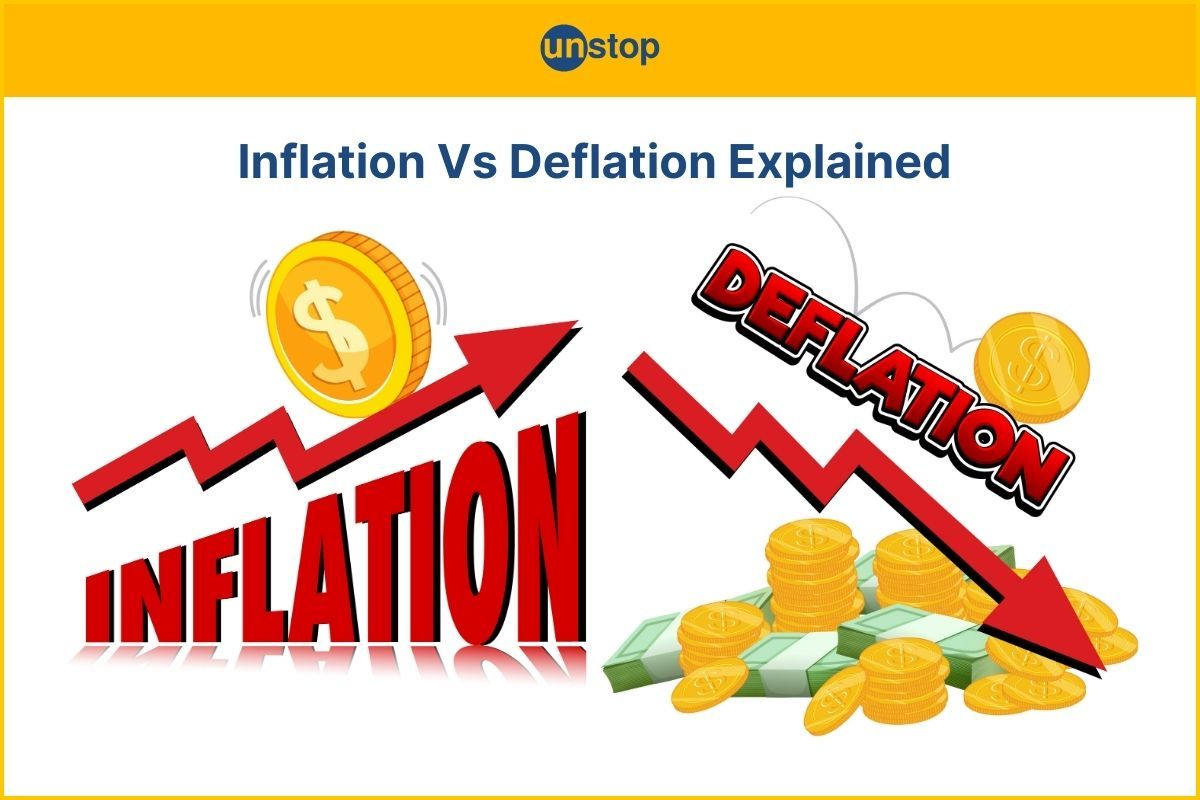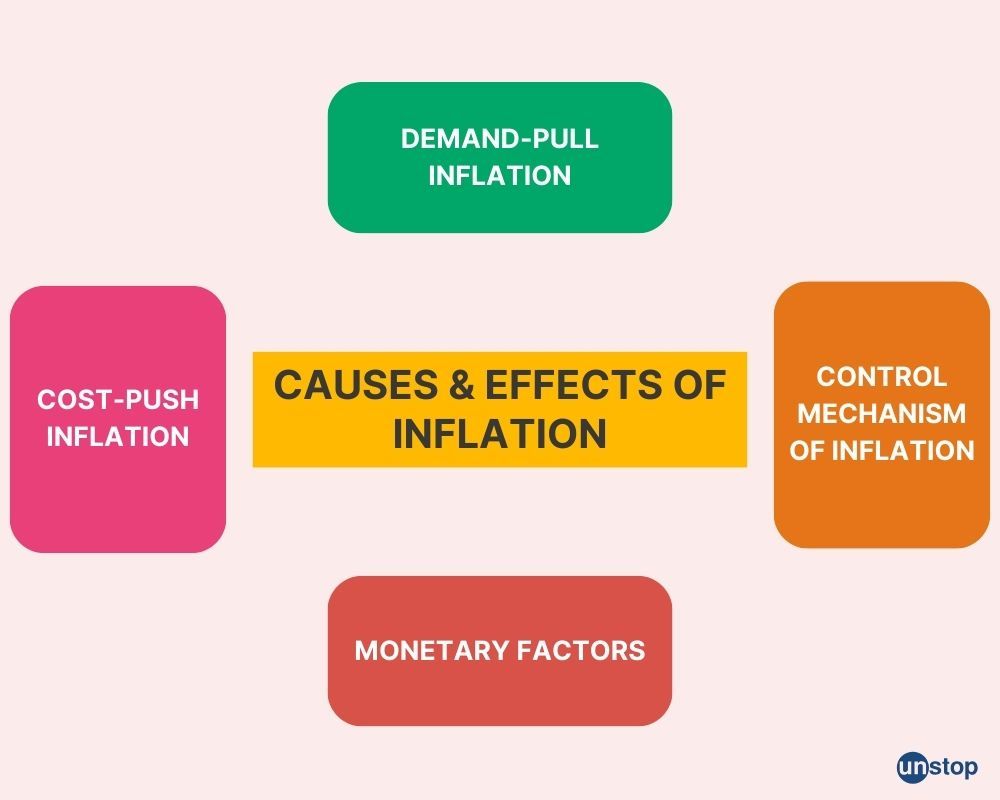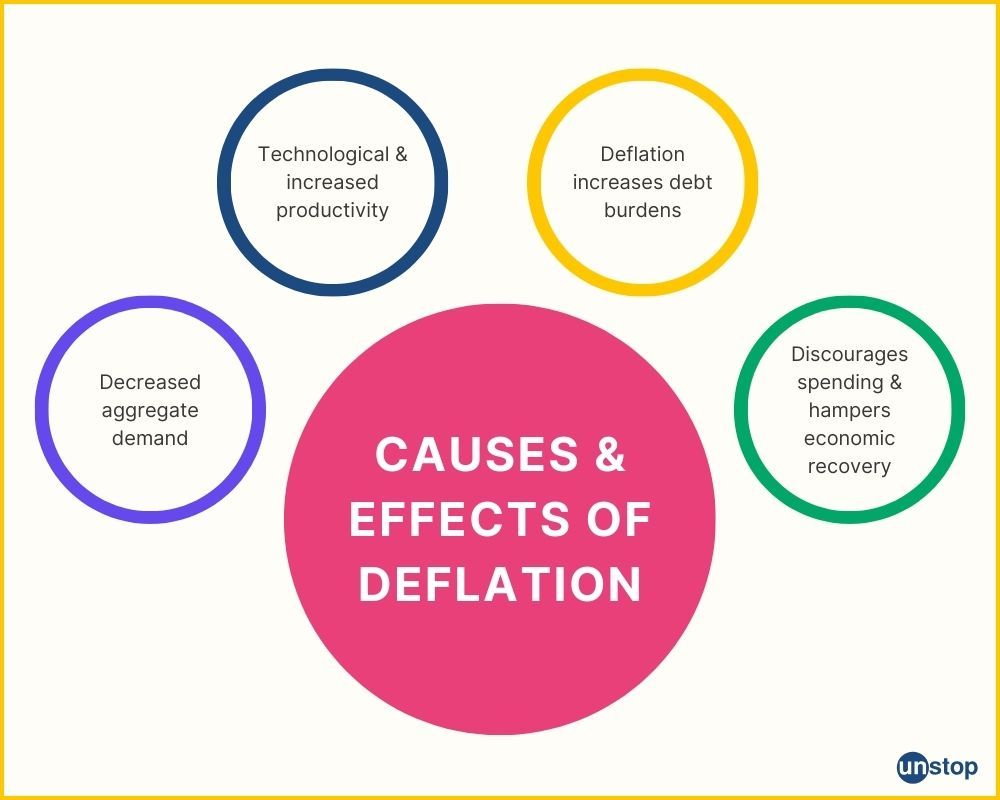- Understanding The Concept Of Inflation
- Causes & Effects Of Inflation
- Understanding The Concept Of Deflation
- Causes & Effects Of Deflation
- Comparing Inflation Vs Deflation
- Frequently Asked Questions (FAQs)
Inflation Vs Deflation: Differences, Causes & Effects Explained

Inflation and deflation are two opposing economic phenomena that have significant impacts on the economy. Understanding the differences between these conditions is vital for economic analysis. They have far-reaching consequences on various aspects of an economy, including employment rates, investment decisions, and overall economic growth.
The balance between these two economic conditions, opposite sides of the same coin, is delicate and an economy can quickly swing from one condition to the other. By understanding how these conditions impact different sectors and individuals, policymakers and economists can make informed decisions to mitigate their adverse effects.
Understanding The Concept Of Inflation
Inflation is a term that you might have heard thrown around in discussions about the economy. Generally, the inflation rate is calculated as the average price change in a basket of commodities and services at a particular time period. The most common measure of inflation is the rate of increase in the consumer price index (CPI). In a trading global economy, exchange rates play an important factor in determining the rate of inflation. But what exactly does it mean? Well, let me break it down for you.
Inflation Refers To A Sustained Increase In The General Price Level
Picture this: you go to the store to buy your favorite snacks, but suddenly everything seems more expensive than before. That's inflation at work! It means that over time, prices tend to rise for most things we buy. So, if you used to pay $1 for a candy bar and now it costs $1.50, that's inflation in action.
It Reduces The Purchasing Power Of Money Over Time
Now, here's where things get interesting. When prices go up due to inflation, our hard-earned money doesn't stretch as far as it used to. Let's say you saved up $100 under your mattress (not literally!). If there's high inflation going on, by the time you decide to spend that money, its value may have decreased significantly. You might find yourself only able to buy half of what you could have bought before! Nevertheless, a modest amount of inflation can actually encourage spending and investing, as inflation can slowly erode the buying power of cash.
Role Of Central Banks During Inflation
You might be wondering why anyone would want inflation if it makes our money worth less. Well, my friends, central banks like the Federal Reserve actually try to maintain a moderate level of inflation because they believe it can help boost economic growth. Most of the world's central banks target modest levels of inflation, at around 2%–3% per year.
Here's how it works: when there is some inflation happening (but not too much!), people are encouraged to spend their money rather than hoard it. This increased spending stimulates businesses and helps keep the economy humming along nicely.
Causes & Effects Of Inflation
Inflation can be caused by various factors that result in a sustained increase in the general price level of goods and services in an economy.

These factors include excessive money supply, demand-pull inflation, cost-push inflation, and inflation expectations.
Demand-Pull Inflation
Demand-pull inflation occurs when there is an excess of aggregate demand compared to the available supply. This situation leads to an increase in prices. When people have more money to spend and are willing to pay higher prices for goods and services, businesses respond by raising their prices. This creates a cycle where demand continues to outpace supply, resulting in inflation.
Cost-Push Inflation
Cost-push inflation happens when there is a rise in production costs that causes prices to go up. Factors such as increasing wages or the cost of raw materials can contribute to this type of inflation. When businesses face higher costs, they pass on these expenses to consumers by charging higher prices for their products or services. As a result, individuals experience the impact of cost-push inflation through increased living expenses.
Monetary Factors
Monetary factors also play a role in causing inflation. Excessive money supply can lead to inflationary pressures within an economy. When there is too much money circulating in the market, it reduces the value of each unit of currency, leading to price increases across various sectors. Central banks and governments need to carefully manage monetary policies and control the money supply to prevent excessive inflation.
Inflation can be caused by a combination of these factors working together or individually. For example, during periods of economic growth when consumer demand is high, both demand-pull and cost-push factors may come into play simultaneously, exacerbating inflationary pressures.
Control Mechanism Of Inflation
Inflation control measures can help stabilize the economy and maintain price stability. Here are some effective ways to control inflation.
-
Central banks often use interest rates as a tool for managing inflation. By increasing interest rates, they aim to reduce borrowing and spending, which helps curb demand-pull inflation.
-
Governments can implement fiscal policies like reducing government spending or increasing taxes during times of high inflation to reduce aggregate demand.
-
Supply-side policies can be employed to address cost-push inflation. These policies focus on improving productivity, reducing production costs, and promoting competition in the market.
Understanding The Concept Of Deflation
Deflation, a term often heard in discussions about the economy, refers to a sustained decrease in the general price level of goods and services. Deflation is different from disinflation, which is a decline in the positive rate of inflation from period to period. While this might sound like a good thing for consumers at first glance, deflation can have significant implications for an economy.
Deflation Increases The Purchasing Power Of Money
One advantage of deflation is that it increases the purchasing power of money. When prices fall, your money can buy more goods and services than before. This can be especially beneficial if you have savings or are looking to make a big purchase. For example, if you were saving up for a new smartphone and prices suddenly dropped due to deflation, you would be able to buy it at a lower cost.
Deflation Leads To Deflationary Spiral
Deflation can hinder economic growth and lead to what economists call a deflationary spiral. This occurs when falling prices lead to reduced consumption and investment. When people expect prices to keep dropping in the future, they may delay purchases in anticipation of even lower prices. This reduction in consumer spending can then cause businesses to cut back on production and lay off workers.
Deflation Creates A Stagnant Economy
In turn, these layoffs contribute to higher unemployment rates and decreased consumer confidence. With fewer people working and spending money, demand for goods and services continues to decline, leading to further price decreases. This vicious cycle can create a stagnant economy with low growth and high unemployment rates.
Role Of Central Banks During Deflation
To prevent or mitigate the negative effects of deflationary spirals, central banks often try to stimulate economic activity by implementing expansionary monetary policies such as lowering interest rates or increasing the money supply. These measures aim to encourage borrowing and spending while discouraging saving.
It's important to note that not all periods of falling prices are considered deflationary episodes. Temporary declines in specific sectors or isolated price decreases do not necessarily indicate overall deflation across an entire economy.
Causes & Effects Of Deflation
Deflation is caused by factors such as decreased consumer spending, technological advancements, or a decrease in the money supply.

The effects of deflation can include lower wages, reduced profits for businesses, increased debt burdens, and a decrease in overall economic activity.
Decreased Aggregate Demand
Deflation, a decrease in the general price level of goods and services, can occur when there is a significant drop in aggregate demand. This decline in demand often arises from various factors such as recessions or financial crises. During these challenging times, people tend to reduce their spending, leading to decreased consumption and investment. As a result, businesses experience lower sales and profits, which may prompt them to cut prices in an attempt to stimulate demand. However, if this reduction in prices becomes widespread across the economy, it can lead to deflationary pressures.
Technological & Increased Productivity
In addition to economic downturns, technological advancements can play a role in causing deflation. When new technologies are introduced that enhance productivity and efficiency, they often lead to cost reductions for businesses. This allows companies to produce goods and services at lower costs, which can then be passed on to consumers through lower prices. While this may seem beneficial for consumers initially, it can create challenges for businesses as they struggle with declining revenues due to reduced selling prices.
Deflation Increases Debt Burdens
While falling prices may seem advantageous on the surface, deflation carries several negative consequences that can hinder economic growth. One significant effect is the increase in real debt burdens. When overall prices decline while debts remain constant or even increase due to interest charges, borrowers find themselves facing higher debt-to-income ratios. This situation makes it harder for individuals and businesses alike to repay their debts effectively.
Discourages Spending & Hampers Economic Recovery
Furthermore, deflation tends to discourage spending among consumers because they anticipate further price declines in the future. Why buy something today if you believe its price will be lower tomorrow? This mindset leads individuals and businesses alike into a cycle of delaying purchases or investments, which further exacerbates the decline in aggregate demand.
Comparing Inflation Vs Deflation
Now, let us make a tabulation of the difference between inflation vs deflation. Understanding the differences between them will go a long way in helping you make informed financial decisions.
Inflation |
Deflation |
|---|---|
|
Increase in the general price level of goods and services over a period of time |
Decrease in the general price level of goods and services over a period of time |
|
Decreases the purchasing power of money |
Increases the purchasing power of money |
|
Caused by factors such as excessive money supply, high demand, or cost-push factors |
Caused by factors such as decreased money supply, low demand, or deflationary spiral |
|
Leads to economic growth and investment |
This leads to economic contraction and decreased investment |
|
Results in wage increases and higher profits for businesses |
Results in wage decreases and lower profits for businesses |
|
Can be managed by monetary policy measures such as interest rate adjustments |
Can be difficult to manage and can require unconventional monetary policy measures |
|
Beneficial for borrowers as the value of debt decreases |
Detrimental for borrowers as the value of debt increases |
|
Erodes the value of savings and fixed-income investments |
Increases the value of savings and fixed-income investments |
|
This leads to increased government spending and budget deficits |
This leads to decreased government spending and budget surpluses |
|
Can cause uncertainty and instability in the economy |
Can cause uncertainty and instability in the economy |
Conclusion
In conclusion, understanding the concepts of inflation and deflation is crucial in comprehending their implications for the economy. Inflation occurs when there is a sustained increase in the general price level, which erodes purchasing power and disrupts economic stability. On the other hand, deflation signifies a persistent decrease in prices, leading to reduced consumer spending and potential economic recession. Both phenomena have significant effects on various sectors, including employment rates, investment decisions, and overall economic growth.
Frequently Asked Questions (FAQs)
1. What are some factors that contribute to inflation?
Inflation can be caused by various factors such as increased demand for goods and services exceeding supply capabilities (demand-pull), rising production costs passed onto consumers (cost-push), excessive money supply leading to devaluation (monetary), or external factors like changes in exchange rates or global commodity prices.
2. How does inflation affect individuals?
Inflation affects individuals by reducing their purchasing power over time. As prices rise steadily, the value of money decreases, making it more challenging to afford goods and services. It can erode savings' value while also impacting borrowing costs and interest rates, affecting both consumers and businesses.
3. What are the consequences of deflation?
Deflation can have adverse effects on the economy, including reduced consumer spending due to expectations of lower prices in the future. This decline in demand can lead to decreased production, layoffs, and increased unemployment rates. Deflation increases the burden of debt repayment and can hinder economic growth.
4. How does the Reserve Bank of India (RBI) control inflation?
The RBI controls inflation through monetary policy tools such as adjusting interest rates, managing money supply, and regulating credit availability. By increasing interest rates or reducing money supply during periods of high inflation, the RBI aims to curb excessive spending and stabilize prices.
5. Can deflation be beneficial for an economy?
While deflation is generally considered undesirable as it signifies economic downturns, mild deflation can have some positive aspects. It may incentivize consumers to save more, stimulate investment by lowering borrowing costs, and encourage price adjustments that reflect true market values. However, prolonged or severe deflation poses significant risks to economic stability.
Suggested reads:
- What Is Glocalization? A Detailed Explanation With Examples
- Experience Curve: An Effective Guide For Strategic Success
- J-Curve: Usages & Effects On Economics And Private Equity
- Electronic Money: All You Need To Know & Be Secured Using It
- Consumer Surplus: Definition, Calculation, Examples & Limitation
Instinctively, I fall for nature, music, humor, reading, writing, listening, traveling, observing, learning, unlearning, friendship, exercise, etc., all these from the cradle to the grave- that's ME! It's my irrefutable belief in the uniqueness of all. I'll vehemently defend your right to be your best while I expect the same from you!
Login to continue reading
And access exclusive content, personalized recommendations, and career-boosting opportunities.
Subscribe
to our newsletter
















Comments
Add comment